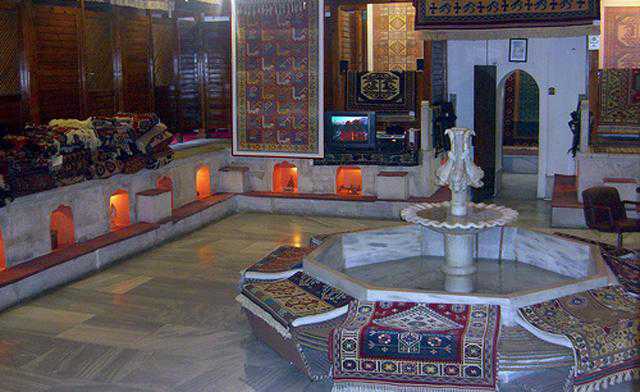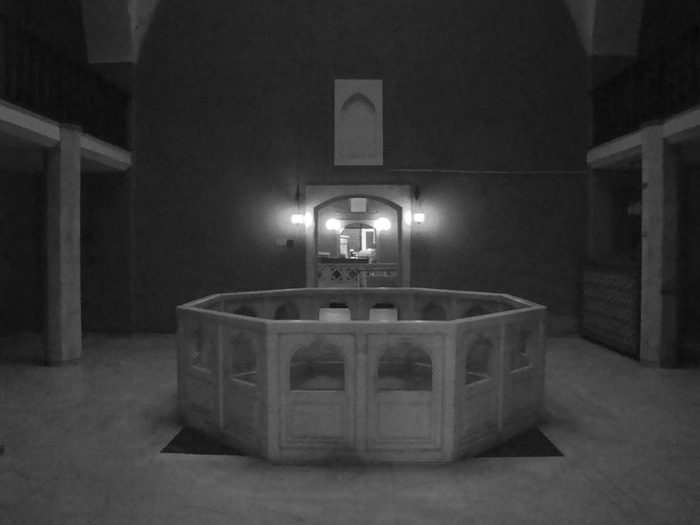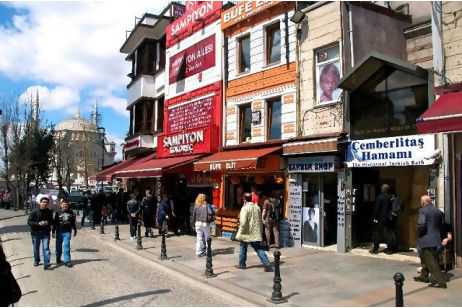Jemma Nicholls
Last Updated: May 20, 2011
The recently opened Espa Spa at the Edition Hotel in Istanbul. Courtesy of the Istanbul Edition
The central stone at the Cemberlitas hammam, one of the city’s oldest baths. Cemberlitas Hamami
I feel like a boiled lobster, red-faced and raw, lying prostrate on a slab where millions of others have been cleansed before me. For my induction to the age-old ritual of the hammam, I have chosen one of Istanbul’s most historic baths, Cemberlitas (www.cemberlitashamami.com), which was built in 1584 by Nurbanu Sultan, the wife of Selim II, who was known for his love of pleasure over politics.
Situated on Divanyolu Street in the heart of the city, and among Istanbul’s greatest monuments – it overlooks the Column of Constantine and is close to the Grand Bazaar and Sultan Ahmet or Blue Mosque – the tall double-domed building is sandwiched in between local shops – a barber’s, fruit and vegetable shop – and a traditional Turkish cafe. Today, Cemberlitas has to shout its presence by a huge white sign and narrow steps leading down to the front doors.
Inside, the reception area is a small kiosk. I wait in a queue of residents and other tourists to pay upfront. As well as the traditional hammam, Cemberlitas also offers other add-on treatments such as body massages, reflexology, manicures, pedicures and waxing. The prices are extremely reasonable and a traditional hammam (entrance fee plus 15-minute body scrub and bubble wash) costs 59 Turkish lira (Dh137). For an added treat, you can include a 30-minute oil massage for an extra 40 lira (Dh93). There is no time limit in the baths themselves and, once you have paid the entrance fee, you can steam, and use the Jacuzzis and relaxation areas for as long as you wish. I make my way through the narrow, humid corridors and into the baths. Late afternoon sunlight streams through the holes pierced in the dome roof. The building consists of three floors and each one appears to have been designed with socialising in mind; large sofas and chairs are placed everywhere and I find women of all ages and sizes lying sprawled, semi-clad, over loungers. This is girl bonding without inhibition.
The attendants are friendly but hurried, and I’m quickly steered into the changing rooms. After being thrust a pair of disposable briefs and a small cotton towel or pestamal, I change and shuffle apprehensively towards the huge double doors.
The heat and steam hits me as soon as the doors to the central bathing area are open. It takes a few seconds for the steam to clear. The palatial room displays all the staples of traditional bathhouse architecture: the Cemberlitas was built as a double bath for men and women, roofed by broad domes more than 18 metres high; a large central hot marble platform is surrounded by kurna, bathing basins, and halvet, private bathing cubicles.
While the architecture is anticipated, nothing prepares me for the sight of 50 semi-clad women lazing, bathing or being massaged on all sides of the room. A moment later a burly attendant whips off my pestamal, throws it to one side and orders me onto the central stone. Modesty has no place here.
I find a space to sit but its skin to skin as we are packed like sardines. I’m later told by the proprietor, Mustafa Bayrak, that more than 500 women and around 350 men bathe here daily. It’s usual for women to come often – his wife enjoys twice-weekly visits with her friends and family for at least six hours at a time.
I look around; three friends are chatting while they wait for their treatments; a mother and her brood of giggling children are bathing in a private wash area and crowds of women are talking nosily in the hot Jacuzzis. A visit to the hammam is not just about cleaning; it’s a social experience.
“It’s the women’s coffee-house, where all news of the town is told, scandal invented …” So wrote Lady Mary Wortley Montagu, describing her first visit to a Turkish bath in Sofia, while travelling with her husband’s embassy to Turkey in 1716 (Turkish Delights, Philippa Scott; 2001).
Twenty minutes later, I’m lying face down on the hot marble stone as my masseuse, Laura, vigorously scrubs me from head to toe with a leifeh, a wash mitt, before flipping me over to scrub the other side. She slides me about, lifting my arms and legs with experience and determination. The scrubbing is rough, like a child who has spent the day playing in the mud and is now being brandished by her furious mother. I’m being repetitively scrubbed and sanded down, scrubbed and sanded down, just as tradition demands.
Next, I ceremoniously douse myself with warm water before a bubble wash with citrus Aleppo soap. Laura rubs the soap into a torba, a silk-like pillowcase, which when combined with the air, creates tiny bubbles that remove any dead skin. “You’ll need lots of soap!” exclaims Laura accusingly as bubbles lather up and completely cover me.
After a final rinsing with tepid water (read cold) to tighten the skin and strengthen the circulatory system, Laura wishes me good health – “sihhatlar olsun”. I’m shown into the Jacuzzi area where I relax in the hot baths before my massage.
Feeling invigorated and cleaner than ever before, I shower and change and complete my experience by indulging in a chicken shwarma from the cafe next door.
After a restful night’s sleep, I head off to experience a contrast: a hammam treatment updated for the 21st century courtesy of the Espa at the new Edition Hotel (www.editionhotels.com), which officially opens next month.
Architecturally, the two “bathhouses” could not be more different. The Edition is housed inside the former 15-storey HSBC headquarters. The exterior is corporate and imposing, striking but not welcoming. Inside it has a minimal, angular coolness but with elegant results. Features include the Espa-managed spa, 78 guest rooms, a Cipriani restaurant, a nightclub and a host of trendy bars.
The benefits of visiting a new spa go beyond blissful solitude. Operational for only a few weeks, the spa is gleaming – the huge rain showers, gym and heated swimming pool looked unused.
Sprawling on three levels, the 1,858sq m spa is an unflinching contemporary take on the Arabesque aesthetic. Decorated in rich wood veneer, embossed bronze floors and leather upholstery, the atmosphere is quiet and serene. Opulent and totally self-indulgent, I feel I could be in any high-end spa in the world, totally removed from the outside hustle and bustle of Istanbul.
The spa’s vast menu is impressive, influenced by customs from around the world, including Turkish culture, and all treatments can be personalised. Keen to compare my experience yesterday with the modern-day take on the hammam (the hammam suite looks exquisite) I opt for Espa’s signature hammam treatment. An hour of pampering costs 250 lira (Dh580) and starts with ritual bathing and scrubbing on the central stone, followed by a honey and milk mask, body massage plus hair wash and conditioner.
I have an hour before my treatment to relax and enjoy the thermal suite. Consisting of multiple steam rooms, saunas, relaxation areas and my personal favourite, an icy snow cabin where, after the sauna, you can brave the real snow of this tiny Swiss Alpine chalet to boost your circulation. These facilities are worth the trip alone. There is no throng chattering around me. The spa has been designed so guests can flutter between the desired facilities in solitude.
The hammam suite – all scented oils and generously proportioned fluffy towels – boasts the traditional large central stone and wash areas but has the added luxury of en suite facilities. And, of course, privacy.
After a long steam session, I’m led to the central stone where the ritual of washing and exfoliating begins. Just the two of us, I’m comfortably wrapped in a towel, unexposed. I immediately relax. This is until the harsh rough leifeh mitt is used to exfoliate my skin. Rigorous and slightly uncomfortable, I quickly realise that this is the truly authentic and essential part of the hammam treatment. Once again I’m sent into the steam room with a glass of iced water to drink. My polished smooth skin is then covered in bubbles, massaged into a thick soapy lather and then gently rinsed off. After my last steam session, my body is enveloped in a warm mixture of milk and honey; I feel wonderfully cocooned as my face and neck are gently massaged.
After the treatment, I glide into the relaxation room. Dark and grand with huge double beds or individual loungers lining the restorative space, it’s a perfect place to unwind with a cold glass of cucumber and lemon water. In stark contrast to Cemberlitas, mobile phones, noisy chatter, fizzy drinks and shwarmas are not welcome here.
By the end of day two, my skin is incredibly soft and it’s impossible to judge whether this is the result of Laura’s rough touch and Aleppo’s finest soap suds or the milk, honey and more modest approach of the Espa treatment. Which do I prefer? Visit the Espa to be indulged, but if you want a traditional hammam, you’ll be disappointed in its glossy halls. And as Mustafa from the Cemberlitas says, “If you’ve never been to a Turkish bath, you’ve missed one of life’s great experiences and never been clean.”
[email protected]





